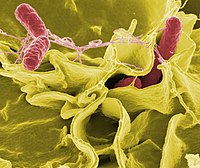
Photo from wikipedia
The mechanisms used by human adapted commensal Neisseria to shape and maintain a niche in their host are poorly defined. These organisms are common members of the mucosal microbiota and… Click to show full abstract
The mechanisms used by human adapted commensal Neisseria to shape and maintain a niche in their host are poorly defined. These organisms are common members of the mucosal microbiota and share many putative host interaction factors with Neisseria meningitidis and Neisseria gonorrhoeae. Evaluating the role of these shared factors during host carriage may provide insight into bacterial mechanisms driving both commensalism and asymptomatic infection across the genus. We identified host interaction factors required for niche development and maintenance through in vivo screening of a transposon mutant library of Neisseria musculi, a commensal of wild-caught mice which persistently and asymptomatically colonizes the oral cavity and gut of CAST/EiJ and A/J mice. Approximately 500 candidate genes involved in long-term host interaction were identified. These included homologs of putative N. meningitidis and N. gonorrhoeae virulence factors which have been shown to modulate host interactions in vitro. Importantly, many candidate genes have no assigned function, illustrating how much remains to be learned about Neisseria persistence. Many genes of unknown function are conserved in human adapted Neisseria species; they are likely to provide a gateway for understanding the mechanisms allowing pathogenic and commensal Neisseria to establish and maintain a niche in their natural hosts. Validation of a subset of candidate genes confirmed a role for a polysaccharide capsule in N. musculi persistence but not colonization. Our findings highlight the potential utility of the Neisseria musculi-mouse model as a tool for studying the pathogenic Neisseria; our work represents a first step towards the identification of novel host interaction factors conserved across the genus.
Journal Title: PLoS Pathogens
Year Published: 2022
Link to full text (if available)
Share on Social Media: Sign Up to like & get
recommendations!